In this article, we discuss the basics of air cleaning and filtration, how to build your own portable air cleaner, and some performance enhancement considerations.
Three general approaches are used for improving indoor air quality, including (i) reducing sources of indoor air pollution, (ii) dilution ventilation, and (iii) air cleaning. Air cleaners are broadly used to reduce contaminant concentrations in buildings. Different technologies are employed to target different types of indoor air contaminants, such as media filtration for removing particles, sorbents for reducing the indoor concentration of organic and inorganic gas-phase pollutants, and ultraviolet germicidal irradiation (UVGI) for inactivating bio-aerosols and microorganisms. Therefore, an air cleaner would be able to remove, clean, or disinfect a specific type or combination of air contaminants (e.g., particles, gaseous contaminants, or microbial contaminants), depending on the types of technologies used.
Air cleaners relying on media filtration are commercially available and commonly used for reducing the concentration of airborne particulate matter from a variety of sources and in a wide range of sizes in residential, commercial, and industrial environments. Particulate matter is known to cause a range of health effects, including irregular heartbeat; decreased lung function; asthma symptom exacerbation; various respiratory symptoms, including coughing, irritation, and difficulty breathing; and decreased cognitive function. Studies that examined particle filtration interventions reported improvements in objective health outcomes and subjective health symptoms, such as asthma and allergy symptoms, once portable air cleaners were used. Even for those without such underlying health concerns, portable air cleaners can be used daily to reduce adverse respiratory health effects by lowering the indoor concentrations of particulate matter that result from regular activities. For example, cooking generates large amounts of airborne particles, which is especially problematic if one does not have or operate a directly-exhausting range hood. A portable air cleaner can be an effective tool to lower particle concentrations and improve health outcomes, while still engaging in regular activities, such as cooking. Moreover, residential heating, ventilation, and air conditioning (HVAC) systems typically operate for a small fraction of the day (a 2018 study found a median runtime of 18%), so even if your building has an HVAC system with filtration, you’ll only be receiving the filtration benefit for a small fraction of the time (i.e., when the system is running). A portable air cleaner allows you to decouple from the central HVAC system and provide targeted on-demand air cleaning in the most regularly occupied spaces. Moving beyond everyday considerations to more extreme scenarios, portable air cleaners can be an effective layer of defense against transmission of airborne infectious diseases, such as coronavirus disease 2019 (COVID-19), in indoor environments, and against extreme weather events, such as wildfires, which are a growing threat and health concern. Herein, we’ll discuss the basics of air cleaners and how you can make your own portable air cleaner and improve the effectiveness of it.
Portable air cleaner performance is commonly reported as a Clean Air Delivery Rate (CADR) in cubic feet per minute (cfm). The CADR is the product of 1) single-pass filtration efficiency (i.e., the fraction of airborne particles removed by the filter as air passes through it once) and 2) the airflow rate passing though the filter area. This means that the CADR can be improved with higher efficiency filters and/or a higher airflow rate. A higher CADR means more particles can be removed from the air, or in other words, a better air cleaning effectiveness. When purchasing a commercially available/off-the-shelf portable air cleaner, the rated CADRs can be compared among units. If building your own do-it-yourself (DIY) portable air cleaner, there are many steps that you can take to increase the CADR.
A simple way to improve the CADR comes when you purchase supplies to build your DIY air cleaner, including the following:
Three systems are regularly used for rating the removal efficiency of air filters, including the Minimum Efficiency Reporting Value (MERV, ranging from 1 to 16), Micro-particle Performance Rating (MPR, ranging from 100 to 2800), and Filter Performance Rating (FPR, ranging from 1 to 10). A higher rating demonstrates a better performance in removing aerosols, including the infectious ones, from the indoor air. It is important to note that air filter removal efficiencies vary among particle sizes. High-efficiency particulate air (HEPA) filters have the best removal performance among air filters by removing more than 99% of all particle sizes.
If you’re interested in learning more about air filter rating systems, you can find additional information here.
The filters you select and how they are attached to the fan impact how much air is actually moved through the filter area, which is one of the determinants of the CADR. Filters resist airflow and induce a back pressure on the fan, which means the fan must work harder to move air through the filters. This typically results in reduced airflow rates through the filter area, compared to fan operation without filters attached. In general, filters with higher particle removal efficiencies tend to have greater resistances to airflow (often described as a high pressure drop across the filter), which results in a larger reduction in airflow. Since it is best to select as high efficiency a filter as possible for particle removal, additional steps can be taken to overcome the associated airflow reductions. Increasing the filter area is one way to help with this issue. Recall that pressure is created by a force applied over an area (i.e., Pressure = Force/Area). A larger filter area will reduce the resistance to airflow and induced pressure since the forces are spread out over a greater area, which will ultimately improve the airflow rate and CADR. When using filters with the same filtration efficiency (e.g., MERV 13), using more filters or a deeper filter to build your air cleaner will increase the filter area and improve the CADR.
You might be wondering just how much airflow resistance and filter area will impact the performance of your unit. Without testing each unit, it is hard to say for certain, since there will be variation in induced resistance and pressure among filter types, brands, and DIY air cleaner configurations and construction. Jim Rosenthal at Tex-Air Filters investigated this very topic and provided a nice summary of the results from increasing the filter depth and the number of filters. In his investigation, installing a 1” MERV 13 filter to a box fan reduced the measured air speed by close to 60% compared to fan operation without a filter. When a single MERV 13 filter of greater depth was used, the air speed improved: a 2” MERV 13 filter and a 4” MERV 13 filter resulted in ~50% and ~40% reductions in measured air speed compared to the fan operation without a filter attached, respectively. Moving beyond filter depth, increasing the filter area by incorporating five filters in a cube configuration resulted in a much lower reduction in air speed (i.e., ~25% reduction in air speed compared to fan operation without a filter attached). Even moving from one to two filters (i.e., from the Parallel to Prism DIY air cleaner option) will improve airflow, as shown from Kris Ray’s 2019 EPA presentation in the figure below. Of course, these results will vary among DIY air cleaners, but increasing filter area, either through filter depth or number of filters, should help to improve the airflow rate through the filters and the resulting CADR.
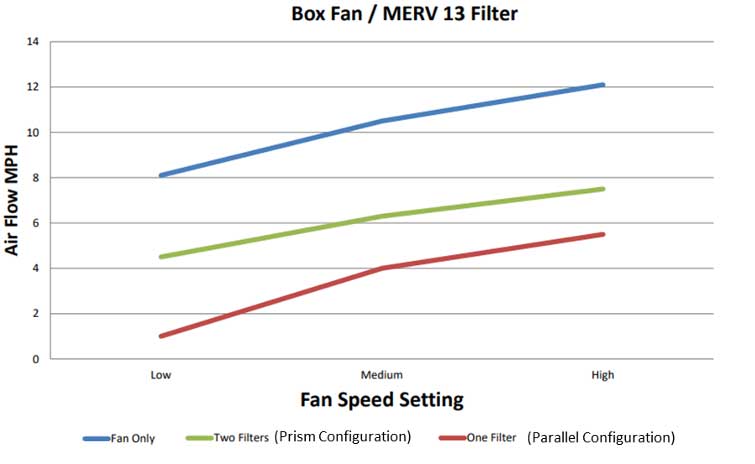
Now we’ll walk you through three DIY options that can cost less and actually be as or more effective than some commercially available units. The DIY options are also helpful during extreme events where the availability of off-the-shelf air cleaners is limited, such as during the COVID-19 pandemic and recent forest fire events in Maui, Hawaii. All three DIY options involve some variation on attaching one or more pleated media air filters to a commercially available box fan. The DIY air cleaners can be used in a variety of indoor spaces, such as schools, offices, and/or your personal residence, to provide targeted airborne particle removal. Note that since media filtration is the only technology implemented in these DIY air cleaners, they only remove airborne particles, including bioaerosols. These devices will not remove gaseous pollutants or inactivate microorganisms.
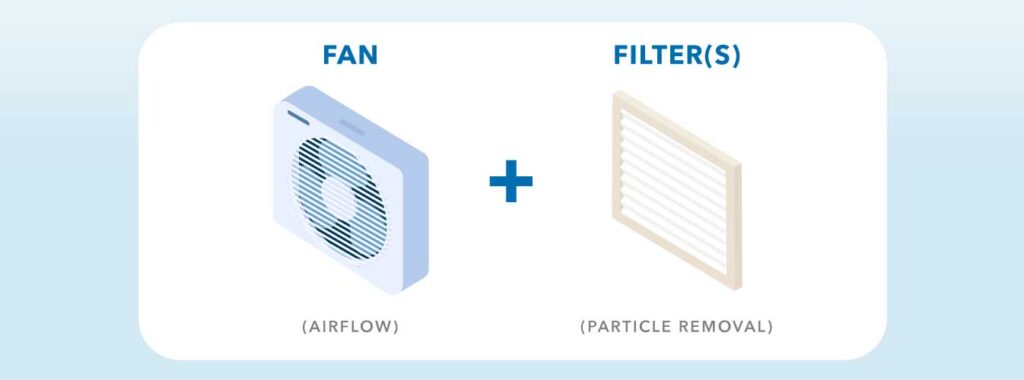
Among the three DIY options, there are trade-offs between (1) air cleaning effectiveness (i.e., CADR) and (2) effort and resources (e.g., time, money, and materials) required to build the unit. As shown in the image below, these two considerations move together: in general, options with a higher CADR require more effort and resources to build.
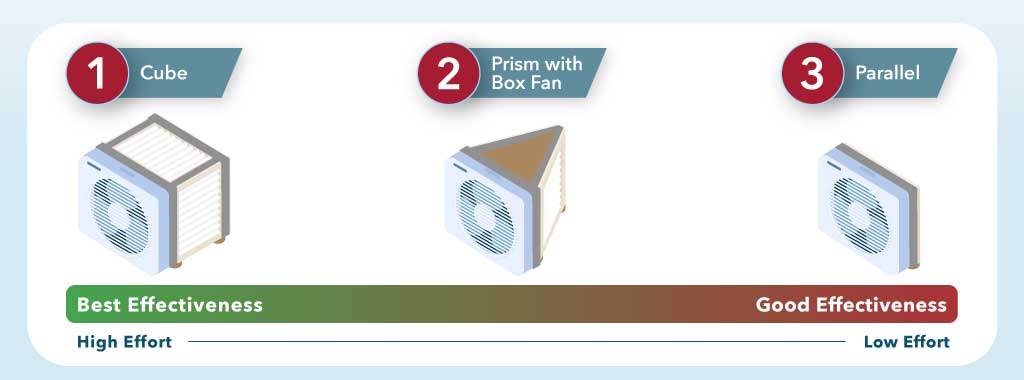
Once you’ve decided on an option to build, follow the instructions for it below. We’ve included all steps in each option’s instructions, so don’t worry about reading all three sections if you already know which option you’re going to build. You can always start with the parallel option and then purchase more filters and upgrade to one of the higher effort and higher CADR options at a later time. If you are really interested in further increasing your unit’s performance, please see the “Extra Considerations” section that follows the DIY instructions.
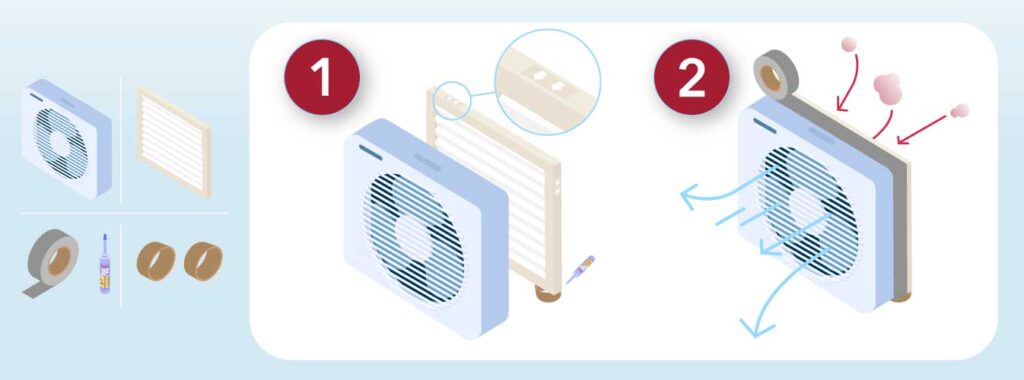
The simplest of all three DIY air cleaners is the Parallel option. It requires the fewest materials and is the easiest to build since it basically involves taping a filter to the back of a box fan. However, this also means it will have the lowest CADR, since it has the lowest filter area and should result in the greatest reduction in airflow, accordingly.
Look for a filter with a high MERV rating (ideally MERV 13 at a minimum and as deep as possible) and a box fan with a high flow rate (look for something like “Maximum Air Flow Capacity (CFM)” on the package or webpage) to help improve effectiveness.
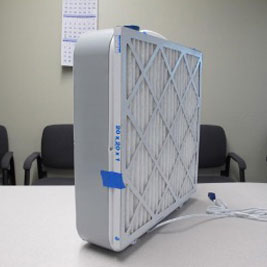
You’re all set! Turn the fan on and locate it in the center of a frequently used room or close to someone who is especially vulnerable, at breathing height. Ensure there isn’t anything blocking the fan’s airflow path and try to run it at as high a speed as possible, noise permitting. Remember, you’re only cleaning the air when the fan is running!
The Prism will take more time and resources to build than the Parallel unit, but it should also offer a higher effectiveness since it incorporates a second air filter and therefore has a higher filter area. This offers a lower resistance to airflow than the Parallel model, which should improve the CADR of this unit.
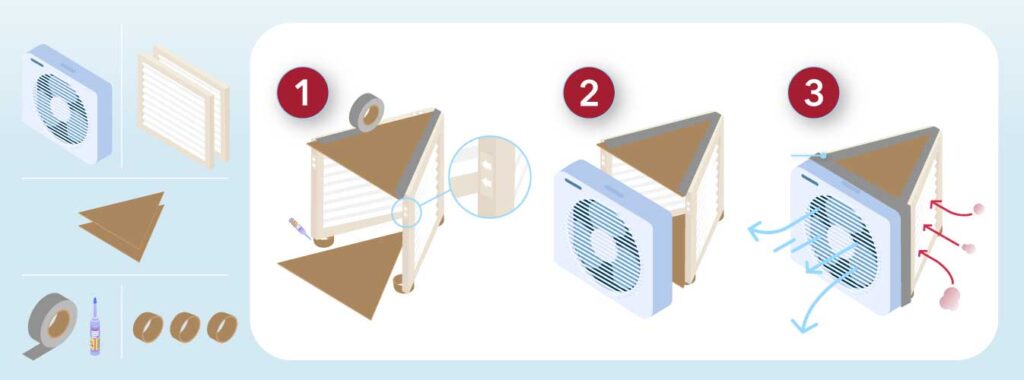
Look for filters with a high MERV rating (ideally MERV 13 at a minimum and as deep as possible) and a box fan with a high flow rate (look for something like “Maximum Air Flow Capacity (CFM)” on the package or webpage) to help improve effectiveness.
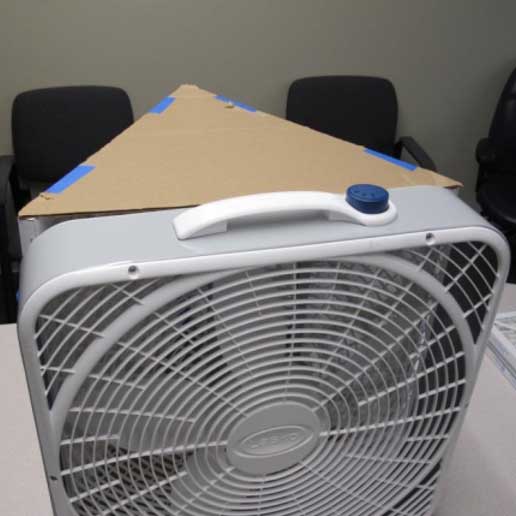
You’re all set! Turn the fan on and locate it in the center of a frequently used room or close to someone who is especially vulnerable, at breathing height. Ensure there isn’t anything blocking the fan’s airflow path and try to run it at as high a speed as possible, noise permitting. Remember, you’re only cleaning the air when the fan is running!
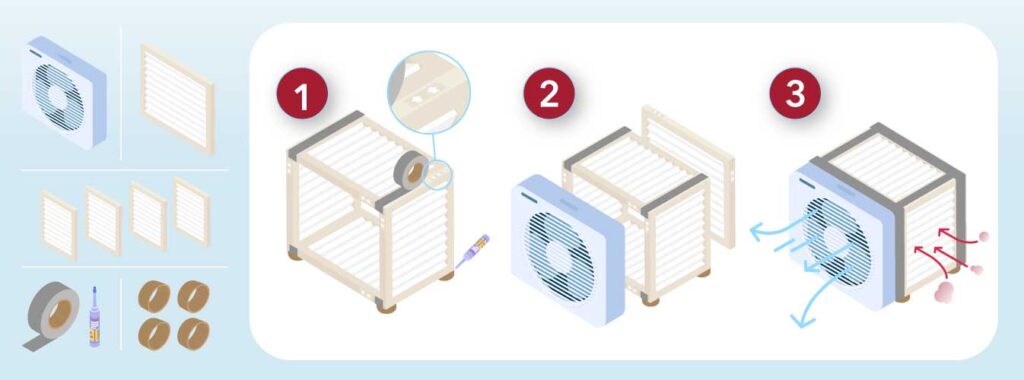
The final DIY option is the Cube, or the “Corsi box” in honor of DIY air cleaner enthusiast Professor Richard Corsi, in collaboration with Jim Rosenthal. The Cube will require the most effort to build, but it should also have the highest CADR since it incorporates five air filters and has the largest filter area!
Look for filters with a high MERV rating (ideally MERV 13 at least) and a box fan with a high flow rate (look for something like “Maximum Air Flow Capacity (CFM)” on the package or webpage) to help improve effectiveness.
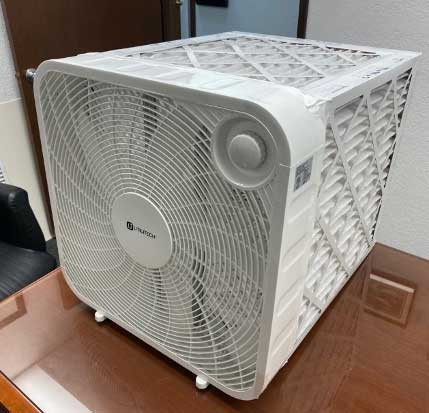
You’re all set! Turn the fan on and locate it in the center of a frequently used room or close to someone who is especially vulnerable, at breathing height. Ensure there isn’t anything blocking the fan’s airflow path and try to run it at as high a speed as possible, noise permitting. Remember, you’re only cleaning the air when the fan is running.
If you’re interested in improving the operation and CADR of your DIY air cleaner, there are a few other steps you can consider beyond the DIY air cleaner option you build and the fan and filter(s) you purchase:
Like filters in a central HVAC system, filters in an air cleaner also require maintenance and replacement. The filter you purchased should have replacement guidance on the package or manufacturer’s website. It would also be wise to keep an eye on the unit to see how “loaded” the filters are (i.e., how much dust has accumulated on the filters). A heavily loaded/soiled filter can negatively impact performance (e.g., through a greater resistance to airflow and bypass around the filter area) and should be replaced. It is good practice to use personal protective equipment, such as gloves and a mask, and ensure the device is off when replacing the filters. Keep in mind that wildfires impact filter performance. Therefore, replace filters after wildfire events.
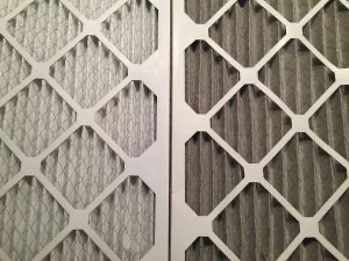
Regardless of which DIY air cleaner option you build, particles are only being removed from the air when the fan is on. Therefore, it’s important to consider comfort considerations, such as fan noise, that could impact how often the air cleaner is actually used. The fan will typically be louder when operated at higher speeds, so it is also a good idea to review sound information (look for a “decibel (sound) rating” on the fan specifications) if the air cleaner will be used in a space where distractions could be especially problematic or if individuals are highly sensitive to or irritated by noise. Fortunately, the resulting sound produced by the DIY air cleaners can be comparable to and even quieter than some commercially available units. Note that like CADR, the sound in practice will vary among DIY units depending on type, materials, and construction. Please refer to the images below or follow these links to see how a Parallel and Cube DIY air cleaner compared to commercially available units.
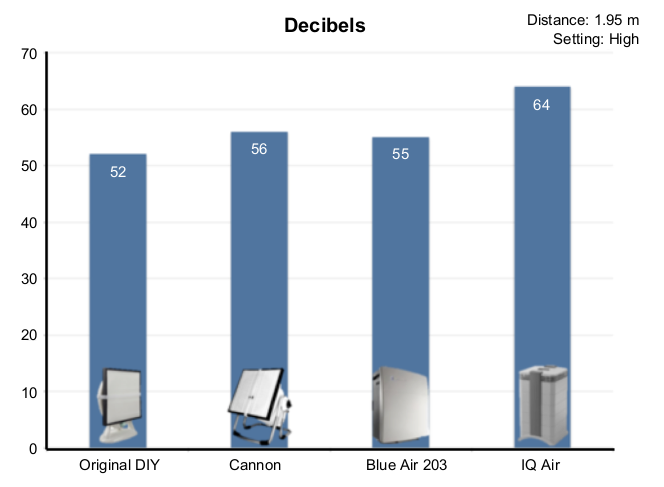
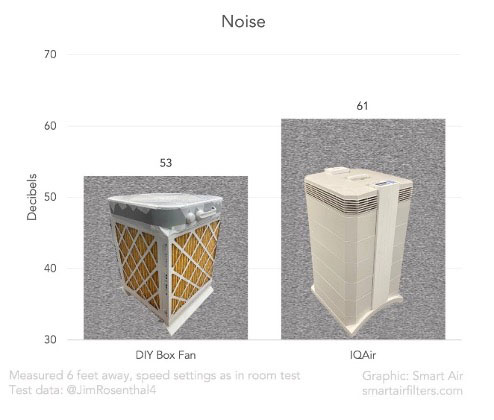
To further improve airflow through the filter area:
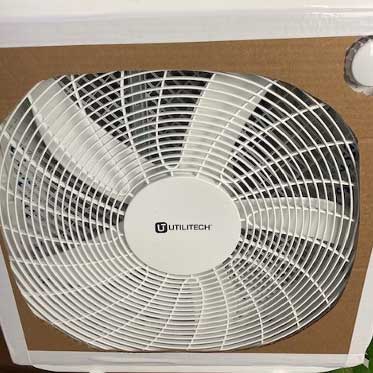

We hope this has been helpful in providing an overview of portable air cleaner basics and instructions to build your own DIY option. If you’re interested in reading more about any of the topics discussed, please follow the hyperlinks throughout this blog or refer to the resources below.
ASHRAE. (2017). ANSI/ASHRAE Standard 52.2-2017: Method of Testing General Ventilation Air-Cleaning Devices for Removal Efficiency by Particle Size. https://www.ashrae.org/File%20Library/Technical%20Resources/COVID-19/52_2_2017_COVID-19_20200401.pdf
Butz AM, Matsui EC, Breysse P, et al. (2011). A Randomized Trial of Air Cleaners and a Health Coach to Improve Indoor Air Quality for Inner-City Children With Asthma and Secondhand Smoke Exposure. Arch Pediatr Adolesc Med. 165(8):741–748. doi:10.1001/archpediatrics.2011.111
Chao J. (2013). Pollution in the Home: Kitchens Can Produce Hazardous Levels of Indoor Pollutants. https://newscenter.lbl.gov/2013/07/23/kitchens-can-produce-hazardous-levels-of-indoor-pollutants/
Davison G, Barkjohn KK, Hagler GSW, Holder AL, Coefield S, Noonan C and Hassett-Sipple B. (2021). Creating Clean Air Spaces During Wildland Fire Smoke Episodes: Web Summit Summary. Front. Public Health 9:508971. doi: 10.3389/fpubh.2021.508971
Fisk, W.J. (2013). Health benefits of particle filtration. Indoor Air, 23: 357-368. https://doi.org/10.1111/ina.12036
Gao X., Coull B., Lin X. et al. (2021). Short-term air pollution, cognitive performance and nonsteroidal anti-inflammatory drug use in the Veterans Affairs Normative Aging Study. Nat Aging 1, 430–437. https://doi.org/10.1038/s43587-021-00060-4
Grundig T., Köksal N., Sing A. (2021). Is an $800 purifier best to clean your home’s air? Marketplace tested5 top brands and their claims. https://www.cbc.ca/news/business/portable-air-purifier-tests-marketplace-1.5900782
Harriman L., Stephens B., Brennan, T. (2019). New Guidance for Residential Air Cleaners. ASHRAE 61 (9): 14–23. www.ashrae.org.
Militello-Hourigan R.E., Miller S.L. (2018). The impacts of cooking and an assessment of indoor air quality in Colorado passive and tightly constructed homes.
Building and Environment. 144: 573-582. https://doi.org/10.1016/j.buildenv.2018.08.044.
Ray K. (2019). Filters in Our Lives, Decreasing Our Exposure to Wildland Smoke. https://www.epa.gov/sites/production/files/2019-07/documents/ray_filters_in_our_lives_decreasing_our_exposure_ray_tagged.pdf.
Rosenthal J. (2020). A Variation on the ‘Box Fan with MERV 13 Filter’ Air Cleaner. https://www.texairfilters.com/a-variation-on-the-box-fan-with-merv-13-filter-air-cleaner/.
Rosenthal J. (2020). Comparing Filters for Resistance and Efficiency. https://www.texairfilters.com/comparing-filters-for-resistance-and-efficiency/
Sacks JD., Wichers Stanek L., Luben TJ., Johns DO., Buckley BJ., Brown JS., Ross M. Particulate Matter-Induced Health Effects: Who Is Susceptible? Environmental Health Perspectives. 119(4): 446-454. doi:10.1289/ehp.1002255
Salimifard P., Jones E., Allen J. (2020). Portable Air Cleaners: Selection and Application Considerations for COVID-19 Risk Reduction. https://schools.forhealth.org/wp-content/uploads/sites/19/2020/08/Harvard-Healthy-Buildings-Program-Portable-Air-Cleaners.pdf#page=4.
Snel, P. (2020). Air filtration a COVID-19: Indoor air quality expert explains how to keep you and your building safe. https://civmin.utoronto.ca/air-filtration-and-covid-19-indoor-air-quality-expert-explains-how-to-keep-you-and-your-building-safe/
Siegel JA. (2016). Primary and secondary consequences of indoor air cleaners. Indoor Air. 26(1):88-96. doi: 10.1111/ina.12194. Epub 2015 Mar 14. PMID: 25689321.
Stephens B., Novoselac A., Siegel JA. (2010). The Effects of Filtration on Pressure Drop and Energy Consumption in Residential HVAC Systems (RP-1299). HVAC&R Research, 16:3, 273-294, DOI: 10.1080/10789669.2010.10390905
Talheim T. (2020). $70 DIY Purifier Effectiveness Better than $1,000 IQAir. Smart Air. https://smartairfilters.com/en/blog/diy-purifier-effectivness/
Talheim T. (2013). Measuring Air Purifier Noise. Smart Air. https://smartairfilters.com/en/blog/china-english-noise/
Touchie, MF, Siegel, JA. (2018) Residential HVAC runtime from smart thermostats: characterization, comparison, and impacts. Indoor Air. 28: 905– 915. https://doi.org/10.1111/ina.12496
US. Environmental Protection Agency. Health and Environmental Effects of Particulate Matter (PM). https://www.epa.gov/pm-pollution/health-and-environmental-effects-particulate-matter-pm.
U.S. Environmental Protection Agency. (2018). Residential Air Cleaners – A Technical Summary. https://www.epa.gov/sites/production/files/2018-07/documents/residential_air_cleaners_- _a_technical_summary_3rd_edition.pdf.
Zhang J., Huntley D., Fox A., Cerhardt B., Vatine A., Cherne J. (2020). Study of Viral Filtration Performance of Residential HVAC Filters. https://www.ashrae.org/file%20library/technical%20resources/covid-19/zhang_digital-first.pdf